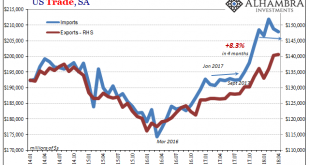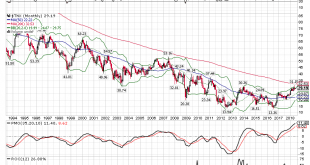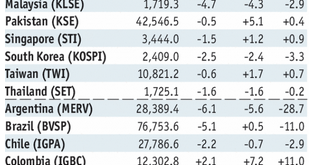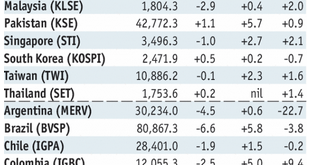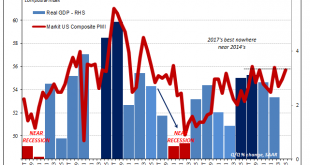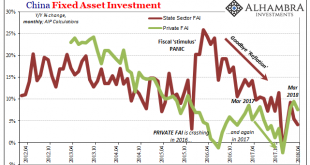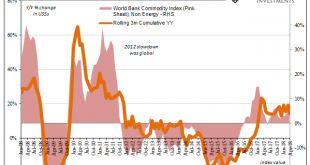US trade is further leveling off after several months of artificial intrusions. On the import side, in particular, first was a very large and obvious boost following last year’s big hurricanes along the Gulf Coast. Starting in September 2017, for four months the value of imported goods jumped by an enormous 8.3% (revised, seasonally-adjusted). Most of the bump related to consumer and capital goods. Since December,...
Read More »Bi-Weekly Economic Review: As Good As It Gets?
In the last update I wondered if growth expectations – and growth – were breaking out to the upside. 10 year Treasury yields were well over the 3% threshold that seemed so ominous and TIPS yields were nearing 1%, a level not seen since early 2011. It looked like we might finally move to a new higher level of growth. Or maybe not. 10 year yields fell nearly 40 basis points in a matter of days as did TIPS yields. The...
Read More »Emerging Markets: Preview of the Week Ahead
Stock Markets EM FX put in a mixed performance Friday, and capped off an overall mixed week. Over that week, the best performers were IDR, TRY, and INR while the worst were BRL, MXN, and ARS. US yields are recovering and likely to put renewed pressure on EM FX. Stock Markets Emerging Markets, May 30 Source: economist.com - Click to enlarge Indonesia Indonesia reports May CPI Monday, which is expected to rise...
Read More »Bi-Weekly Economic Review – VIDEO
[embedded content] Interview with Joe Calhoun about BiWeekly Economic Review 01/06/2018. Related posts: The Currency of PMI’s Why The Last One Still Matters (IP Revisions) The Dismal Boom Central Bank Transparency, Or Doing Deliberate Dollar Deals With The Devil What About 2.62 percent? More Pieces of Impossible Not Do We Need One, But Do We Need...
Read More »Emerging Market Preview: Week Ahead
Stock Markets EM FX has started the week mixed. Some relief was seen as US rates stalled out last week, but this Friday’s jobs number could be key for the next leg of this dollar rally. On Wednesday, the Fed releases its Beige book for the upcoming June 13 FOMC meeting, where a 25 bp hike is widely expected. We believe EM FX remains vulnerable to further losses. Stock Markets Emerging Markets, May 23 Source:...
Read More »Chinas A-Aktien: Alles bereit für das MSCI-Debüt
Skyline von Shanghai (Bild: Pixabay) Ab dem ersten Juni werden in Yuan kotierte chinesische Aktien in die regionalen und globalen MSCI-Indizes eingeschlossen. Nicholas Yeo von Aberdeen Standard Investments sieht darin ein grosses Anlagepotential. Am ersten Juni starten die chinesischen A-Aktien durch. Es hat lange gedauert, aber jetzt werden bis zu 234 in Yuan kotierten Aktien chinesischer...
Read More »The Currency of PMI’s
Markit Economics released the flash results from several of its key surveys. Included is manufacturing in Japan (lower), as well as composites (manufacturing plus services) for the United States and Europe. Within the EU, Markit offers details for France and Germany. Given the nature of sentiment surveys, we tend to ignore these most months unless they suggest either pending changes or extremes. Beginning with the US,...
Read More »Anchoring Globally Synchronized Growth, Or We Gave Up Long Ago?
January was the last month in which China’s National Bureau of Statistics (NBS) specifically mentioned Fixed Asset Investment (FAI) of state holding enterprises (or SOE’s). For the month of December 2017, the NBS reported accumulated growth (meaning for all of 2017) in this channel of 10.1%. Through FAI of SOE’s, Chinese authorities in early 2016 had panicked themselves into unleashing considerable “stimulus.” There...
Read More »All The World’s A (Imagined) Labor Shortage
Last year’s infatuation with globally synchronized growth was at least understandable. From a certain, narrow point of view, Europe’s economy had accelerated. So, too, it seemed later in the year for the US economy. The Bank of Japan was actually talking about ending QQE with inflation in sight, and the PBOC was purportedly tightening as China’s economy appeared to many ready for its rebound. Operating under these...
Read More »Viel Potenzial bei nachhaltigen Investitionen
Bild: Finanz und Wirtschaft Forum Das Forum "Nachhaltig Investieren 2018" der Finanz und Wirtschaft war von vorsichtigem Optimismus geprägt, dass sich ESG-Kriterien durchsetzen werden. Ein Standard existiert allerdings noch nicht. Zudem wurde das Schweizer Pensionskassenmodell kritisch beleuchtet. Ende 2016 wurden weltweit 22,9 Billionen USD in nachhaltigen Strategien (ESG), investiert. Dies...
Read More » Swiss Economicblogs.org
Swiss Economicblogs.org

